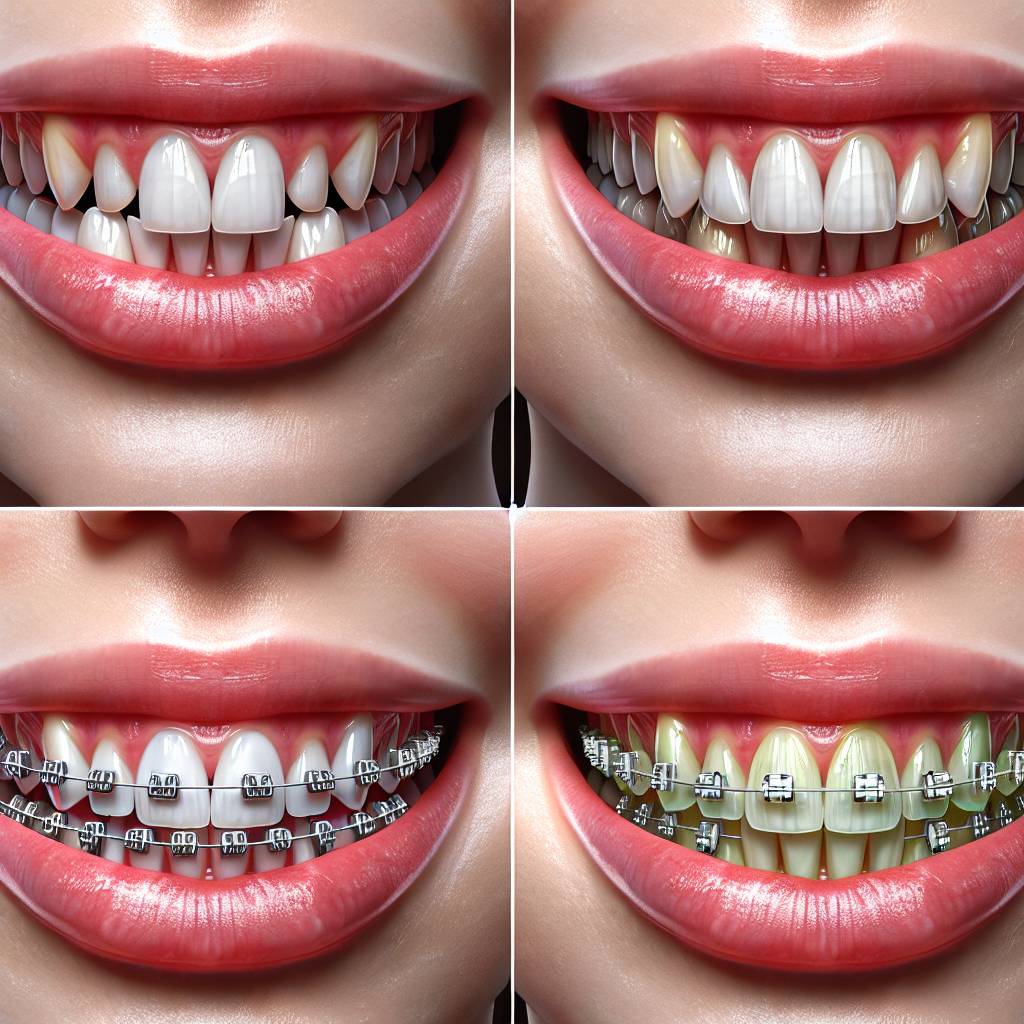Having flared teeth can be an embarrassing issue to deal with, but the good news is that there are ways to correct this problem. The answer to the question of how long it takes to fix flared teeth depends on several factors, including the extent of the flare and the type of treatment chosen. Generally speaking, orthodontic treatments such as braces or Invisalign can take anywhere from 6 months to more than a year in order to produce results, while more invasive treatments such as veneers or bonding can take less time. In any case, it is important to consult with your dentist in order to determine which treatment is right for you and how long it will take for you to see results.Flared teeth are teeth that are wider at the top than they are at the bottom. They typically appear in the front of the mouth, either in the upper or lower arch. The wider shape of flared teeth gives them a triangle-like shape when viewed from the front. In some cases, flared teeth may lead to crowding and other orthodontic issues.
Flared Teeth
Flared teeth is a condition which results in the upper and/or lower front teeth extending outward or “flaring” away from the other teeth. This can cause an individual to have an unbalanced and asymmetrical smile. There are a few causes of flared teeth, including genetics, jaw growth, and misaligned bite.
Genetics
Genetics are thought to be one of the most common causes of flared teeth. Flared teeth can be hereditary, meaning it runs in families. If one or both parents have a history of flared teeth, it is likely that their children will inherit this trait as well.
Jaw Growth
Jaw growth can also cause flared teeth. If the lower jaw grows too far forward, it can push the front teeth outward, resulting in a flaring of both the upper and lower front teeth. Jaw growth can be caused by habits such as thumb sucking or tongue thrusting which can affect the development of a child’s jaw.
Misaligned Bite
Lastly, misaligned bite is another cause of flared teeth. When the upper and lower jaws do not fit together correctly due to crooked or crowded teeth, this can lead to an uneven bite which may result in flared front teeth. This type of misalignment can also be caused by habits such as thumb sucking or tongue thrusting which disrupts proper jaw development and alignment.
Diagnosing Flared Teeth
Flared teeth, also known as buck teeth, are a common dental issue that can be easily diagnosed by your dentist. Flared teeth occur when the upper front teeth protrude out beyond the lower teeth, giving the appearance of an overbite. While not necessarily dangerous to your health, many people are self-conscious about this condition and want to fix it. Fortunately, there are a variety of treatments available for this issue.
Your dentist will start by evaluating your teeth to determine if you have flared teeth and how severe the condition is. They may take X-rays or use other imaging techniques to assess the underlying structure of the teeth. Depending on the severity of the condition, they may recommend orthodontic treatment such as braces or Invisalign to help move the teeth back into position. In more severe cases, they may suggest a surgical option such as jaw surgery which can help reposition the bones in your mouth and improve your bite alignment.
Your dentist may also suggest lifestyle changes such as avoiding hard foods or eating more slowly in order to reduce wear and tear on your teeth. They might also recommend wearing a mouthguard while sleeping or playing sports to protect your teeth from further damage. Finally, they may suggest regular checkups and cleanings so they can monitor any changes in your dental health and make adjustments, if necessary.
Flared teeth can be embarrassing, but luckily there are a variety of treatments available that can help address this issue. If you think you have flared teeth or are concerned about any other dental issues, be sure to visit your dentist for an evaluation so they can diagnose the problem correctly and recommend an appropriate treatment plan for you.
Treatments for Flared Teeth
Flared teeth are a common dental problem that can be caused by a variety of issues, such as genetics, injury or excessive wear. Flared teeth are characterized by a gap between the adjacent teeth and an outward tilt of the tooth crowns. This often leads to reduced function and aesthetic concerns. Fortunately, there are several treatments available to address the issue.
Braces are one of the most popular methods used to treat flared teeth. Braces can help correct misaligned or crooked teeth by applying gentle pressure over time to move them into their correct position. In many cases, braces may be used in combination with other treatments such as veneers or crowns in order to achieve optimal results.
Invisalign is another option for treating flared teeth. This treatment uses clear aligners that fit over the teeth and gradually move them into alignment without the need for metal braces. Invisalign is ideal for those who want a more discreet orthodontic treatment and don’t want others to notice their braces.
Veneers are also a great option for treating flared teeth. Veneers are thin shells that can be bonded to the front of your existing teeth in order to improve their appearance and symmetry. Veneers can help close gaps between your teeth and restore their natural shape and size, giving you an improved smile in just a few visits to your dentist’s office.
Crowns are another common treatment used to treat flared teeth. Crowns can be used to cover damaged or misshapen teeth in order to restore their normal appearance and function. Crowns are usually made from porcelain or ceramic materials that closely match the color of your natural tooth enamel, giving you a more aesthetically pleasing smile.
If you have flared teeth, it’s important to talk with your dentist about which treatment option is best for you. They will evaluate your individual case and help you decide which treatment will give you the best outcome.
Orthodontic Braces
Orthodontic braces are a type of dental appliances used to correct misaligned teeth and jaws. They are typically made from metal brackets, wires, and rubber bands. Orthodontic braces work by placing gentle pressure on the teeth and jaws, which helps to reposition them into their proper alignment. Treatment with braces can take anywhere from six months to three years depending on the severity of the misalignment. Braces can be used by both children and adults, although they are most commonly used in teenagers.
Flared Teeth
Flared teeth is a dental condition where the upper or lower front teeth stick out further than normal. This condition can be caused by genetics, poor oral hygiene habits, or even facial trauma due to an accident or injury. Flared teeth may also occur if an individual has an overbite or underbite. Treatment for flared teeth usually involves orthodontic braces that apply pressure to push the teeth back into their proper alignment. Depending on the severity of the misalignment, treatment with braces may take several months or even years.

Dental Crowns
A dental crown is a type of restoration that completely covers the entire visible part of a tooth. This type of restoration is used to strengthen a weak or damaged tooth, improve its appearance, and restore its shape and size. It is also used to protect a cracked tooth from further damage, or to hold a dental bridge in place. Dental crowns are made from a variety of materials, such as porcelain, metal, or composite resin. Depending on the location and condition of the affected tooth, your dentist may recommend either a permanent or temporary dental crown.
Flared Teeth
Flared teeth are teeth that have been ground down so that they have an outward sloping shape near the gum line. This condition is usually caused by excessive grinding and clenching of the teeth due to stress or other medical conditions. Flared teeth can cause discomfort when eating and speaking, as well as aesthetic concerns. Treatment for flared teeth typically involves reshaping the teeth with restorative dentistry procedures such as veneers or crowns. In some cases, orthodontic treatment may be necessary to properly align the teeth and restore their original shape.
Dental Veneers
Dental veneers are thin porcelain shells that are custom-made to fit over the front surfaces of teeth. They can improve the shape, size, and color of teeth, and are used to mask imperfections like gaps, chips, and discoloration. The procedure for getting veneers usually involves two visits to the dentist. During the first visit, the dentist will take an impression of your teeth and send it to a dental laboratory where the veneers will be made. During the second visit, your dentist will bond the veneers to your teeth using special adhesive cement.
Flared Teeth
Flared teeth is a condition in which one or more of your upper front teeth stick out further than the others. This can give your smile an uneven appearance and may also cause you discomfort when eating or speaking. Orthodontic treatment with braces or aligners is usually recommended for correcting flared teeth. This treatment works by applying gentle pressure to gradually move your teeth into their desired positions. In some cases, dental veneers may also be used to improve the appearance of flared teeth by making them look straighter and more even.
Recovery Time for Fixing Flared Teeth
The recovery time for fixing flared teeth will depend on the condition of the teeth and the type of treatment that is required. In most cases, the treatment for flared teeth can be completed in one or two visits to the dentist. During these visits, the dentist will examine your mouth and determine what treatment is necessary to correct the problem. Depending on your individual needs, you may require orthodontic braces, veneers, crowns, or other types of treatments to improve your smile.
Once your dentist has determined what type of treatment is required to fix your flared teeth, they will discuss with you the expected recovery time. Depending on the complexity of your case, it may take several months or even up to a year for your teeth to be corrected. Your recovery time will also depend on how well you follow post-treatment instructions and maintain good oral hygiene practices.
During this time, it is important to practice good oral hygiene habits and attend regular checkups with your dentist so that they can monitor your progress and make any necessary adjustments as needed. It is also important to avoid hard foods such as nuts and popcorn that can damage or dislodge braces or other dental appliances that may have been used during treatment. Additionally, you should avoid smoking as this has been linked to an increased risk of gum disease and other oral health problems.
By following these steps and attending regular checkups with your dentist, you can ensure that your recovery time from fixing flared teeth is minimized and that you get the best results possible from your treatment.

Conclusion
Flared teeth can be caused by a variety of factors, ranging from genetics to misaligned bite. Fortunately, there are a variety of treatment options available for correcting flared teeth. The most appropriate treatment option for any individual depends on the cause and severity of the issue. In general, it may take anywhere from several weeks to several months to fix flared teeth, depending on the type of treatment used. Regardless of the approach taken, it is important to maintain good oral hygiene and regular visits to the dentist in order to ensure that your newly corrected smile lasts for many years to come.
Ultimately, fixing flared teeth can help restore confidence and enhance your overall appearance. With the right combination of treatments and preventive measures, you can enjoy a beautiful smile that will last for years to come!

